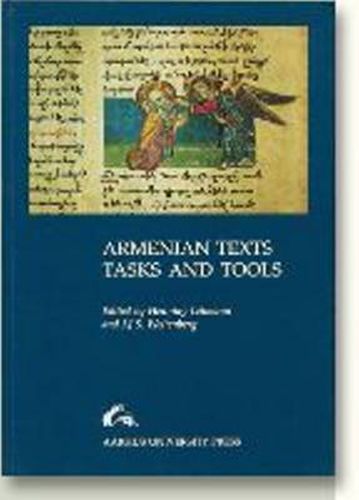Readings Newsletter
Become a Readings Member to make your shopping experience even easier.
Sign in or sign up for free!
You’re not far away from qualifying for FREE standard shipping within Australia
You’ve qualified for FREE standard shipping within Australia
The cart is loading…






This collection of papers from a workshop held in Sandbjerg in July 1989 had as its subject, Priorities, Problems and Techniques of Text Editions . The papers comment on the principal questions - how do we today set priorities and solve problems connected with the study of Armenian manuscripts. and the edition of texts contained in the treasuries of Armenian maunuscript collections. A general evaluation of how to assess various readings in Armenian manuscripts, and how to relate textual criticism proper to other fields of studies, such as linguistics and computer application was given by the president of the Association Internationale des Etudes Armeniennes (AIEA), Michael E. Stone, who also introduced the workshop by enumerating a number of the tasks lying immediately aheacd of scholars concerned with Armenian text editions, and emphasizing their importance. For the Armenian Bible, problems and principals in editing biblical texts are dealt with in four papers, more generally in a paper by S. Peter Cowe who also touches upon the intriguing question of isolating and defining readings of the Vetus Armena (Arm 1) in Bible manuscripts and elsewhere. Two papers deal with the usefulness, indeed necessity of sorting out the manuscript materials through delineating the stemma of a given text, in particular, the text of the Bible. Archbishop Shahe Adjamian introduced participants in the workshop to the Zeyt'unyan edition of Genesis, not least Dr L. Ter-Petrossian’s presentation of historical topics concerning the background, genesis and early history of the Armenian Bible, in the introduction to this new Erevan Bible project. Henning J. Lehmann presents a homily by Severian of Gabala, transmitted on Armenian soil both in an early classical and a Hellenizing version, allowing readers to compare directly a primary and a secondary Armenian translation. Christian Hannick, in a short communication announced the publication of a hymnarion, reflecting the translation activities of Chalcedonian Armenians under Byzantine suzerainty and therefore entailing questions of both a liturgical, a dogmatic and an editorial nature. Also, smaller texts than the bible may have a very complicated historyof transmission which, even if obscure, can often be - partly or fully clarified when Greek manuscripts and Oriental versions are evaluated together. This is demonstrated by Michel van Esbroeck, with particular attention to the testimony from one new Armenian witness to the apocryphal Acts of John. Nira Stone raises the question of the relationship between text and illustration, and points to a number of cases where their interdependence is of particular importance. Finally, Dickran Kouymjian provides a general survey of inscribed Armenian manuscript bindings, singling out a group of manuscripts of New Julfa provenance.
$9.00 standard shipping within Australia
FREE standard shipping within Australia for orders over $100.00
Express & International shipping calculated at checkout
This collection of papers from a workshop held in Sandbjerg in July 1989 had as its subject, Priorities, Problems and Techniques of Text Editions . The papers comment on the principal questions - how do we today set priorities and solve problems connected with the study of Armenian manuscripts. and the edition of texts contained in the treasuries of Armenian maunuscript collections. A general evaluation of how to assess various readings in Armenian manuscripts, and how to relate textual criticism proper to other fields of studies, such as linguistics and computer application was given by the president of the Association Internationale des Etudes Armeniennes (AIEA), Michael E. Stone, who also introduced the workshop by enumerating a number of the tasks lying immediately aheacd of scholars concerned with Armenian text editions, and emphasizing their importance. For the Armenian Bible, problems and principals in editing biblical texts are dealt with in four papers, more generally in a paper by S. Peter Cowe who also touches upon the intriguing question of isolating and defining readings of the Vetus Armena (Arm 1) in Bible manuscripts and elsewhere. Two papers deal with the usefulness, indeed necessity of sorting out the manuscript materials through delineating the stemma of a given text, in particular, the text of the Bible. Archbishop Shahe Adjamian introduced participants in the workshop to the Zeyt'unyan edition of Genesis, not least Dr L. Ter-Petrossian’s presentation of historical topics concerning the background, genesis and early history of the Armenian Bible, in the introduction to this new Erevan Bible project. Henning J. Lehmann presents a homily by Severian of Gabala, transmitted on Armenian soil both in an early classical and a Hellenizing version, allowing readers to compare directly a primary and a secondary Armenian translation. Christian Hannick, in a short communication announced the publication of a hymnarion, reflecting the translation activities of Chalcedonian Armenians under Byzantine suzerainty and therefore entailing questions of both a liturgical, a dogmatic and an editorial nature. Also, smaller texts than the bible may have a very complicated historyof transmission which, even if obscure, can often be - partly or fully clarified when Greek manuscripts and Oriental versions are evaluated together. This is demonstrated by Michel van Esbroeck, with particular attention to the testimony from one new Armenian witness to the apocryphal Acts of John. Nira Stone raises the question of the relationship between text and illustration, and points to a number of cases where their interdependence is of particular importance. Finally, Dickran Kouymjian provides a general survey of inscribed Armenian manuscript bindings, singling out a group of manuscripts of New Julfa provenance.